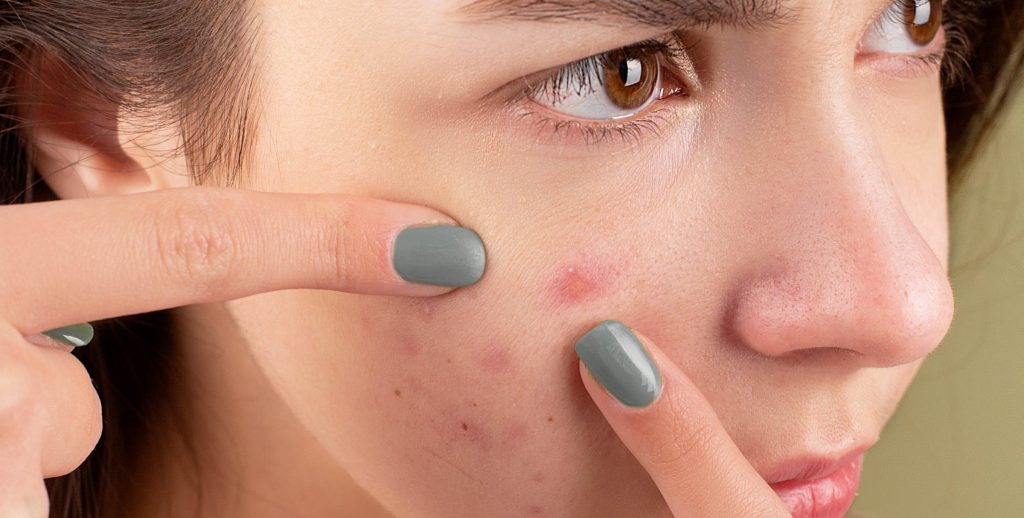Can STDs cause pimples?
Sexually transmitted infections (STIs), sometimes called sexually transmitted diseases (STDs), cause all sorts of symptoms. But one of the more unnerving symptoms of STIs can be pimples.
So, how can you tell if these pimples are a symptom of an STI? Keep reading to find out.

What counts as a pimple?
A pimple is a type of acne that occurs when hair follicles, or pores, become clogged with oil and dead skin cells. This blockage can cause bacteria to grow, leading to inflammation and the formation of a pimple. Pimples are generally characterised by red, inflamed spots that may have a white centre.
There are four main types of pimples:
- Papules: These are inflamed blemishes that appear as red bumps or lumps on the skin. They do not have a white head.
- Pustules: These are similar to papules but have a white tip in the centre caused by a build-up of pus.
- Nodules: These are large hard lumps that build up beneath the surface of the skin and can be painful.
- Cysts: These are large pus-filled lumps that look similar to boils and carry the greatest risk of causing permanent scarring.
It’s important to note that not all skin blemishes are pimples. For example, blackheads and whiteheads are types of acne but are not considered pimples because they are not inflamed.
Can STIs cause pimples?
Yes and no.
The technical definition of a pimple can be misleading. Indeed, many people will encounter a skin blemish of some kind and think of it as a pimple. While some STIs can cause pimples, there are other STIs that can cause skin blemishes that can be mistaken for pimples.
Below are a few STIs that can cause pimple-like blemishes on the skin.
Herpes
Herpes Simplex Virus has two types: HSV 1 and HSV 2.
HSV 1, more commonly called Oral Herpes, can cause fluid-filled blisters to appear in and around the mouth. HSV 2, known as Genital Herpes, will cause these same blisters to appear in and around the genital area. When these blisters break, they often leave painful, crusted sores behind.
These blisters can easily be mistaken for pimples.
HPV
The Human Papillomavirus (HPV) is the most common STI and can cause Genital Warts, which appear as painless growths around the vagina, anus, or penis. The warts may be flat or cauliflower-like. They may appear alone or in clusters.
Syphilis
In the primary stage of Syphilis, a chancre forms at the initial site of infection, usually the genitals but can also be found in the mouth and around the anus. This chancre is usually round and firm and could be mistaken for a harmless skin blemish. It usually doesn’t hurt or itch, so unless you see it, you wouldn’t know you had it, especially if it appears in an area that you don’t normally see, like your throat or anal region. It will often turn from a pimple into an ulcer.
In the secondary stage of Syphilis, the patient may develop a skin rash with rough red or brown spots, which will not hurt or itch. These may be mistaken for pimples. Many people with secondary Syphilis also feel tired or run down.
Final thoughts
Pimples and other skin blemishes may be harmless, but they may also be the cause of something more serious. If you’re concerned about any skin blemishes you have and think you may have an STI, you should get tested with Better2Know as soon as possible.
Call the number on this page to speak to our friendly team of Sexual Health Advisors. They can talk you through your situation to help you choose the right STI screen and clinic for you.
This article has been medically reviewed by Dr. Steve Chapman, 11/06/2024.
Categories
- Awards
- Bacterial Vaginosis
- Blood Tests
- Cardiovascular Health
- Cervical Cancer
- Chlamydia
- Condoms
- Covid-19
- Gardnerella
- Genital Warts
- Gonorrhoea
- Health and Wellness
- Hepatitis A
- Hepatitis B
- Hepatitis C
- Herpes
- HIV
- HIV (AIDS)
- Home Testing
- HPV
- Instant Testing
- MSM
- Mycoplasma
- News
- Non-Specific Urethritis
- PAP Smear
- Pre-Pregnancy
- Sexual Health
- STD Symptoms
- STD Tests and Screens
- STI Transmission
- Stigma
- STIs
- Swab Tests
- Syphilis
- Trichomonas
- Ureaplasma
- WSW
- Zika
